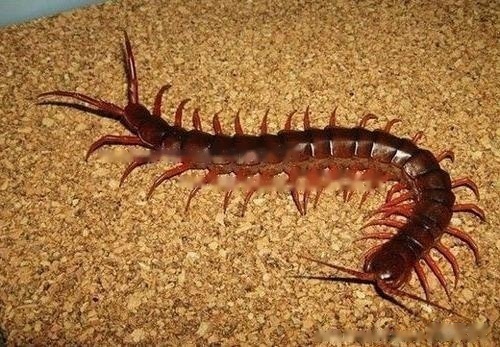Because the Chinese red giant dragon centipede is a multi-segmented worm and is also known as a centipede, its internal structure is difficult to know if you don't understand it. It is divided into digestive system, respiratory system, The circulatory system, the excretory system, the reproductive system, and the nervous system, these six systems are distributed in which part of the centipede? Let's discuss it together!

Chinese Red Giant Dragon Centipede
Digestive System
The digestive system consists of digestion tract and digestive glands. Food enters the digestive tract from the mouth, and only after mechanical action and chemical decomposition can be absorbed and utilized by centipedes. The digestive tract is simple. From the mouth to the anus, it is a straight tube running through the center of the body. Behind the mouth is an enlarged pharynx, which is conducive to sucking food. The digestive tract behind the pharynx is divided into three parts: foregut, midgut and hindgut. The foregut and hindgut are short, but the midgut is long. The foregut mainly plays the role of receiving, transporting and initially digesting food. The midgut is the main place for food digestion and absorption, and the hindgut is responsible for the formation of feces and the excretion of the anus to the tail section. Digestive glands are a pair of grape-shaped salivary glands, which open to the foregut through salivary ducts. The salivary glands can secrete saliva containing digestive enzymes, which can wet and initially decompose food.
Respiratory System
Centipedes use the tracheal system to breathe. The trachea is an elastic tubular structure formed by the indentation of the body wall, and there are chitin spirals on the wall, which can support the trachea to facilitate gas circulation. The trachea has many branches, which are distributed between the cells and tissues of the body wall in the body. The trachea has openings on both sides of the body that communicate with the outside—the stomata, which are the recesses left when the trachea is formed. The centipede has a total of 6 pairs of stomata, which are in the 4th, 6th, 9th, 13th and 15th sections, respectively. The other sections are degraded, leaving only a trace. Each valve has an opening device, so that the valve can be opened and closed, and the gas can flow in and out without obstruction when it is opened.
circulatory system
The circulatory system of the centipede is open-tube circulation, but it is relatively developed. The tubular heart is on the back of the digestive tract and runs through the trunk. , and surrounded by pericardium, from back to front into the head artery leading to the various organs of the head. In addition to the anterior dorsal vessels, a pair of lateral arteries surround the alimentary canal and converge on the ventral surface of the alimentary canal to form supraneural vessels, which branch into the blood lumen. In addition, the centipede has a pair of heart holes in each section except the terminal segments, and the heart holes are the openings for blood to enter the heart from the blood sinus.
Excretory system
The centipede's excretory trachea is the Malpighian canal. It is an unbranched blind canal that arises at the mid-hindgut junction. The blind end of the Malpighian canal is free in the blood cavity, and absorbs the waste generated by metabolism from the blood, and sends it into the hindgut. After reabsorbing the water in the hindgut, it is excreted through the anus together with the feces.
Nervous system
The centipede's nervous system is similar to that of earthworms and belongs to the chain-like nervous system. It includes one cranial ganglion, which is distributed from the nerves to the antennae and eyes, and has two nerves connected to the inferior esophageal ganglion. After that, there are 2 posterior ventral nerve cords and a pair of ganglia in each segment. The ganglia heal with the healing of the somites, and each pair of ganglia sends out nerves to each somite to regulate the body's activities.
Reproductive System
Centipedes are dioecious. The gonads of the reproductive system of the centipede are all on the back of the digestive tract, which is a single ovary or testis. It consists of a reproductive tube, the fallopian tube or the vas deferens, which is later divided into two, which go down the digestive tract and open into the male and female genital pores respectively. In addition, there are two pairs of accessory gonads leading to the end of the genital duct. The female centipede has two fertilizing vesicles, and the male centipede has two seminal vesicles, which all lead to the end of the fallopian tube and the vas deferens. The female centipede fills the body cavity when the eggs are mature, and the mother before giving birth stores sperm in the fertilization sac, so that the fully mature egg can be combined with the sperm during ovulation to become a fertilized egg and discharged.
![[Dog Training 5] The training method of pet dog dining etiquette](/static/img/12192/12192_1.jpg)




